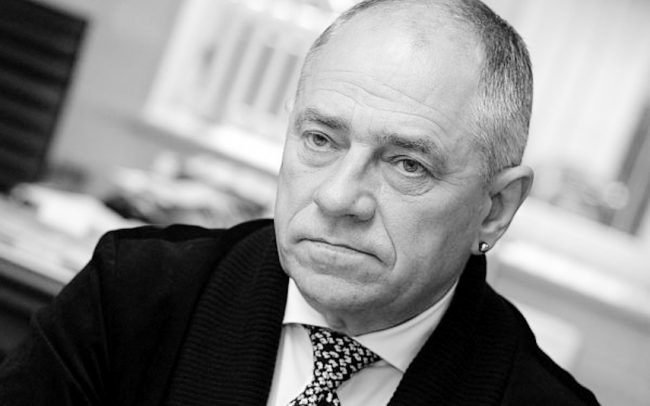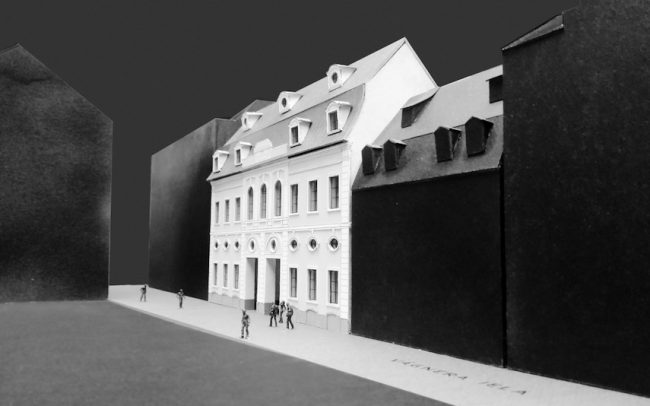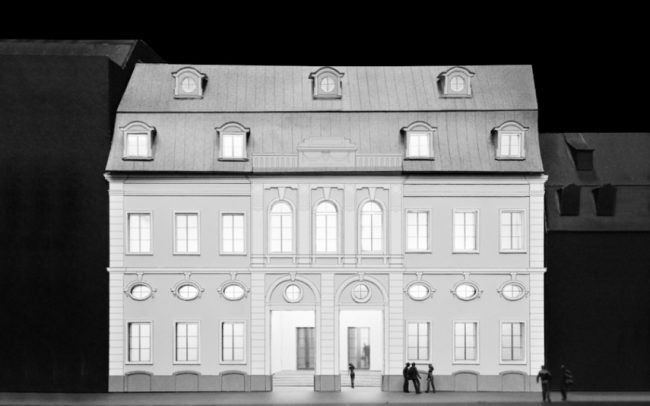Swan song for former Latvian PM Maris Gailis as efforts intensify to save Riga’s Wagner House
The Latvian entrepreneur and politician Maris Gailis could be enjoying his retirement. However, Gailis who served 462 days as Latvia’s Prime Minister is a man who likes challenges. His newest, which has become an all-consuming passion, is to see the Wagner House and Theatre in Riga’s Old Town return to its former glory and again bustle with artistic activity.
To assist him in his efforts, Gailis has enlisted the support of several noted individuals, including Richard Wagner’s great-granddaughter, the opera manager Eva Wagner-Pasquier, who visited Riga for the launch of a massive campaign to raise awareness of the deteriorating state of the building. The message that something needs to be done was clear. “The time of talking needs to stop and action is required,” Gailis told The Baltic Times.
Raising awareness of the condition of the building and Gailis’ plans have both kicked off in earnest. “Our campaign started in October last year. It was to have featured 800 singers. However, due to inclement weather, 400 singers assembled and braved the rain and marched through Riga singing the Pilgrims Chorus from Wagner’s opera Tannhauser. They made their way to the Wagner House and Theatre to affirm that the building is not only part of Riga’s musical and cultural legacy, but a legacy that belongs to the world,” Gailis said.
The building was last used in 2007 when the concert hall was forced to shut its doors in response to worsening structural conditions. It was put in the possession of the Latvian Ministry of Finance, who entrusted management of the building in 2005 to SJSC State Real Estate.
According to Gailis the building has major structure damage, cracks in the walls, problems with leaking water and mould. SJSC State Real Estate believes that the hall is a monument of cultural heritage which must be renovated as soon as the necessary funding is found.
“But until then we must be able to provide at least the minimum conditions for the preservation of the building’s cultural heritage and values,” the Latvian Ministry of Culture informed The Baltic Times.
“Thank goodness that the Latvian government keeps the heating on in the building during the winter and allocates money for this purpose. This has avoided further deterioration,” Gailis said.
The average annual heating cost for the building over the past five years has totalled €7,000, including VAT. In turn, the total direct expenditure of maintaining the building, including utilities, the maintenance of engineering networks, staff salaries, household supplies, and repair works total on average €17,500 per year.
According to a technical inspection report which was carried out in January, the building was found to be in a partially satisfactory technical condition.
“Bearing witness that this architectural monument which is of national interest has been progressively eroding under the impact of time, the Ministry of Culture, despite not being the owner of the building, ordered a feasibility study (calculations of the economic financial viability of a public-private partnership) of the development possibilities for the Wagner Hall,” the Ministry of Culture noted.
The Ministry of Culture has been actively engaged in the work of a commission that was established by the building’s owner. The commission has developed a report setting out the possibilities for the building’s future development. After examining the report, the Latvian Cabinet of Ministers will decide on a renovation model.
The Ministry of Culture supports that the vision offered by the working group, which envisages the renovation of the Wagner Hall will be in line with the nation’s financial possibilities. The Ministry of Culture believes that public investment or a public-private partnership for the renovation of the Wagner Hall would be to the most appropriate action.
“There have been many individuals in the past that have been involved in trying to preserve the building’s cultural value, but there’s been much talk and little action. Nevertheless, at least they pushed the project forward, and now we’re working in the same direction,” Gailis said.
Gailis founded the Wagner Society of Latvia which has provided him with a platform to drive the ideas which he’s been developing and envisioned for the Wagner House and Theatre. He’s enlisted the support of his wife who’s drawn up his project’s design plans. Gailis’ wife is Zaiga Gaile from the architecture firm Zaigas Gailes Birojs, one of the leading and renowned architect companies in the Baltic States. Gailis said that if he undertakes this project, he’ll do it his way.
“Normally, Wagner societies around the world deal with scholarships, concerts and education, but in our case the Wagner Society of Latvia’s main goal and priority at the moment is to restore the theatre where Wagner conducted,” Gailis said.
The original German Theatre was built in 1782 by the Baltic-German architect Christoph Haberland, and served as the city’s cultural centre for over a century until it was destroyed in the mid-19th century after Riga built a new opera house.
“My wife has already designed a third version of my proposal where we’ll rebuild a 400-seat theatre. Wagner‘s legacy that Latvia has been entrusted with in this house and theatre also belongs to the world,” Gailis noted.
Richard Wagner arrived in Riga in 1837, becoming the first Chief Conductor of the City Theatre at the age of 24. During his two years as Kapellmeister he oversaw the production of 39 operas. His dismissal came only as a response to the composer’s alleged financial misdeeds in Riga.
A controversial figure, Wagner developed a number of innovations whilst in Riga that changed opera and classical music forever, and he holds an indelible role in the musical history of Latvia’s capital.
Wagner implemented four major ideas whilst employed at the theatre. Firstly, he conducted facing the orchestra, with his back turned to the audience. He also lit only the stage where the performance was taking place. “The idea apparently came about as the citizens of Riga were greedy and didn’t want to pay for candle lighting in the audience area, which was a normal practice in European theatres at the time. This partly provided lighting for audience members to show off their clothing, and enabled them to see each other,” Gailis said.
Wagner realised that lighting only the stage would allow the audience to concentrate solely on the performance. So the audience area was darkened. Whilst in Riga, Wagner was already developing his ideas for a new theatre which he would replicate in Bayreuth. A theatre having good sight lines and good acoustics for all, and similar in design to a Greek amphitheatre. Lastly, the orchestra was placed partially under the stage which assisted dampening the sound so as to not drown out the singers on stage. “It somehow also helped with the resonating of the sound. Wagner’s time in Riga greatly influenced his future design plans for the Bayreuth Theatre,” Gailis noted.
Gailis believes that he’s put together a great design plan for the restoration of the building, along with a great team of experts.
“My wife is working with Europe’s leading theatre advisers and theatre designers based in Amsterdam, who are also involved in this Wagner project which I’m proposing. I have other specialists working on the museum part,” said Gailis.
“This means that we’re well prepared against any other project ideas that may perhaps come in later when the government announces a tender. This is our advantage, and no one can blame us, as this is our idea. We’ve been working on our idea for three years. Nevertheless, let’s wait and see what the government decides.”
“The Latvian government however does also have other priorities. A new concert hall, for example. The Minister of Culture informed me that they’re no longer considering the Merks concert hall proposal at Skanste, which I didn’t like. The Ministry of Culture has again opened up to the idea of the possibility of the wonderful concert hall proposal by the architect Andis Silis on the AB Dam, near the Latvian National Library.”
‘‘However, the restoration efforts would need to proceed in tandem with any other concert hall proposal, because if the Wagner project goes ahead The Latvian Ministry of Finance may forget about what is perhaps the country’s main priority, namely a large 2,000-seat concert hall.”
“The Ministry of Finance has prepared three proposals concerning what to do with the Wagner House and Theatre building. The first is not to sell it, which is politically not acceptable. It would be rented out to generate income, which again is stupid, except if you perhaps convert it into a hotel or casino. This would mean nobody could undertake this from a commercial point of view. It’s impossible. The second option is a private-public partnership, which we support. The third option would be for the government to finance the renovations completely and allocate funds to the Ministry of Culture to operate the building.”
“However, I must thank The Baltic Times for the new idea that our interview placed into my mind of seeking funds from abroad for the restoration efforts, perhaps from Wagner lovers, multinational companies or wealthy cultured individuals and so on. This never occurred to me.”
Even so, Gailis believes he’d need to raise approximately €20 million for the plan he’s proposing. “But to pursue this option, all legal issues and requirements would have to be discussed with the Ministry of Culture. And we’d need an auditing firm to monitor any funds raised, as well as expenditures,” said Gailis
“But Wagner’s great-granddaughter, Eva Wagner-Pasquier, is in a position to help us, within any Ministry of Culture legal framework of course, to raise money in Germany. And from Bayreuth, Horst Eggers the chairman of the Richard Wagner International Associations around the world is also ready to help, as are several German politicians I met in Bayreuth during my visits there attending Wagner’s Bayreuth Festival.”
Gailis has on two previous occasions raised large sums of money. The first was in connection to his circumnavigation of the world in 2000, which companies financed. The amount was approximately US$500,000, and was connected with advertising, a film and a book. On the second occasion he raised €400,000 for the award-winning Zanis Lipke Memorial on the island of Kipsala in Riga, which Gailis’ construction company built.
For now it’s a waiting game for Gailis. “At least the government has the proposal on the agenda,” he said.
“Hopefully in May it will appear on the government’s timetable. It remains very important for me, as the government concludes working in November and who knows who’ll be in the next government. My aim is to have until September/October a government decision on what proposal it will pursue. However, it’s being discussed, and they now know that it can’t be thrown out.”
At the moment, everyone on Gailis’ team is working on the project on a voluntary basis, and are driven by a shared passion and commitment.
“I trust that this project may be a sort of swan song of my life. I am, however, no longer a young man. And I’ve become sick and tired of dealing with bureaucracy, but I’ll continue to devote all my available energy, along with a great group of individuals who share my passion and love of Wagner, to see the Wagner House and Theatre finally restored and renovated, and for Riga to take its place as a Wagner city.”
Wagner wrote the first two acts of his opera Rienzi while in Riga, and he claimed in his 1870 autobiography Mein Leben (My life) that he’d been inspired to write The Flying Dutchman following a stormy sea crossing he made from Riga to London in 1839.
Avots: www.baltictimes.com



